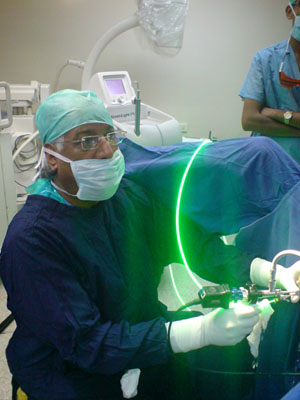 Prostate laser surgery is used to relieve moderate to severe urinary symptoms caused by an enlarged prostate, a condition known as benign prostatic hyperplasia (BPH).
Prostate laser surgery is used to relieve moderate to severe urinary symptoms caused by an enlarged prostate, a condition known as benign prostatic hyperplasia (BPH).
During prostate laser surgery in Delhi, your urologist in Delhi inserts a scope through the tip of your penis into the tube that carries urine from your bladder (urethra). The urethra is surrounded by the prostate. A laser is passed through the scope. The laser delivers energy that is used to shrink or to remove the excess tissue that is blocking the urethra and preventing urine flow.
All lasers use concentrated light to generate precise and intense heat. Laser surgery removes excess prostate tissue by:
Ablation. The laser melts away excess tissue.
Enucleation. The laser cuts away excess prostate tissue.
There are different types of prostate laser surgery, such as:
Photoselective vaporization of the prostate (PVP). A laser is used to melt away (vaporize) excess prostate tissue to enlarge the urinary channel.
Holmium laser ablation of the prostate (HoLAP). This is a similar procedure to PVP, except that a different type of laser is used to melt away (vaporize) the excess prostate tissue.
Holmium laser enucleation of the prostate (HoLEP). The laser is used to cut and remove the excess tissue that is blocking the urethra. Another instrument, called a morcellator, is then used to chop the prostate tissue into small pieces that are easily removed.
Prostate laser surgery helps reduce urinary symptoms caused by BPH. Urinary symptoms caused by BPH can include:
- Frequent, urgent need to urinate
- Difficulty starting urination
- Slow (prolonged) urination
- Increased frequency of urination at night (nocturia)
- Stopping and starting again while urinating
- The feeling you can’t completely empty your bladder
- Urinary tract infections
Laser surgery may also be done to treat or prevent complications due to blocked urine flow, such as:
- Recurring urinary tract infections
- Kidney or bladder damage
- Inability to control urination (incontinence) or an inability to urinate at all (urinary retention)
- Bladder stones
- Recurring blood in your urine
A number of procedures are available to treat BPH, but laser surgery has several potential advantages over other methods, such as transurethral resection of the prostate (TURP) and open prostatectomy. The advantages generally include:
- Lower risk of bleeding. Because there is a low risk of bleeding with laser surgery, it can be a good option for men who take medication to thin their blood or who have a bleeding disorder that doesn’t allow their blood to clot normally.
- Shorter or no hospital stay. Laser surgery can be done on an outpatient basis or with just an overnight hospital stay. Other prostate treatments, such as open prostatectomy or transurethral resection of the prostate (TURP), may require a longer hospital stay.
- Quicker recovery. Recovery from laser surgery generally takes less time than recovery from TURP or open surgery.
- Less need for a catheter. Procedures to treat an enlarged prostate generally require use of a tube (catheter) to drain urine from the bladder after surgery. With laser surgery, a catheter is generally needed for less than 24 hours.
- More-immediate results. Improvements in urinary symptoms from laser surgery are noticeable right away, while it can take several weeks to months to see noticeable improvement with medications.

